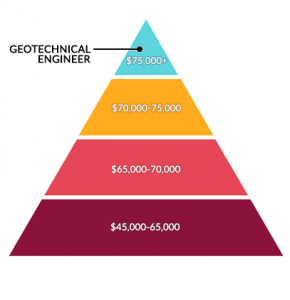The Definitive Guide for Geotheta
The Definitive Guide for Geotheta
Blog Article
The Buzz on Geotheta
Table of ContentsOur Geotheta IdeasAn Unbiased View of GeothetaUnknown Facts About GeothetaThe Basic Principles Of Geotheta
They work together with civil engineers, structural designers, designers, and other professionals to incorporate geotechnical considerations into the total job style and building process. This calls for efficient teamwork, control, and communication to make sure that the geotechnical facets align with the job objectives and satisfy regulatory requirements.Mining & Products Engineering: Concepts of boring, penetration prices, and aspects impacting the selection of boring method. Characteristics of nitroglycerins, firing systems and blast patterns. Blowing up methods in surface and below ground functions. Unique blasting strategies at excavation perimeters. Resonance and noise control. Mechanical and constant methods to fragmentation, consisting of longwall shearing and fullface boring.
Modelling of fragment and bit dimension distributions; comminution as a transfer function. Comminution technology: squashing, grinding, dimension classification. Integrated analysis of fragmentation and comminution procedures. Offered by: Mining & Materials Design.
Rumored Buzz on Geotheta
Bachelor's degree programs in civil, geotechnical, geological, and ecological design generally last four years and include general education programs in English, social scientific research, and the liberal arts, along with courses in sophisticated maths, architectural geology, and fluid mineralogy. (https://www.abnewswire.com/companyname/geotheta.com_139529.html#detail-tab)
Geotechnical design involves the evaluation of the dirt and rock problems at a particular site, and their ramifications for the growth of that site. As many frameworks count on the ground for assistance, it lacks surprise that a thorough understanding of the ground conditions, and the suitability of foundation systems, are crucial to the long-term stability and efficiency of the structure or framework.
Specialising in the examination of geological developments and ground behavior, geotechnical designers carry out scientific examinations and screening to comprehend the impact these geological formations may have on the style and building of structure, civil and framework projects. This proficiency is vital for the style and building of structures, roadways, tunnels, dams, bridges, and water system and sewer system.
The geotechnical team at Douglas Partners regularly seek advice from engineers, layout designers, designers, and builders to make suggestions on design and growth propositions to make certain that the built structures are accordingly created for the ground conditions. As an example, the design of footing systems needs to consider the weight of the framework, the capacity of the ground to support that weight along with movement resistances and effective building.
The 10-Second Trick For Geotheta
This job is considerably simplified by the use our Douglas Map geospatial system which makes this info readily obtainable in a simple to use internet browser interface. A geotechnical engineer will certainly direct the drilling of boreholes and test pits to accumulate soil and various other examples, and likewise assess surface attributes and ground exposures to look at this site develop a geotechnical version of the subsurface conditions.
Relying on the project type and ground problems came across, laboratory screening may to name a few points examine stamina, compressibility, reactivity and/or permeability of dirt and rock samples. After this data is gathered and collated, the outcomes are made use of for a geotechnical model of the site, which is generally provided as areas throughout the website.

A geotechnical examination by nature can only analyze the ground conditions at the locations pierced or excavated. Natural variants in soil and rock conditions can happen throughout a site and between test places. It is as a result excellent technique that the geotechnical designer be retained throughout building of the job to give on-site confirmation that the ground problems encountered follow the expectations and suggestions given in the geotechnical investigation record.
The Main Principles Of Geotheta
Geotechnical designers use their extensive knowledge of dirt and rock to analyze danger and resolve problems on diverse infrastructure projectsGeotechnical design is a specialist branch of civil design which checks out the behavior of earth materials and the application of dirt and rock technicians. Tailings Engineer. As a geotechnical designer, you will assess the physical, mechanical and chemical buildings of soil and rock in order to design structures, keeping frameworks and earthworks
Geotechnical engineering is carefully connected to and overlaps with, both engineering geology and ground design - https://www.cheaperseeker.com/u/geotheta. It's feasible to be experts in geotechnics or benefit a geotechnical company but be known as a design rock hound or a ground engineer. As a geotechnical engineer, you'll require to: develop and preserve relationships with customers and various other specialists involved in the site, throughout each projectmaintain safety criteria on site bear in mind price ramifications when you make recommendationsstudy geological maps and aerial photos from a variety of resources and from different time periodsexamine building and construction prepares to see just how practical they are based on your understanding of the siteinvestigate dangers or geological risks for the sitesearch for eco sensitive attributes, such as garbage dump beginning to establish accurate and interpretive ground modelsplan area investigationsdrill and analyse examples of bedrock, dirt, groundwater and extra products supervise various other professionals on sitesolve technical concerns as they occur, such as unanticipated structures at drill sitesmonitor conditions throughout and after construction to ensure frameworks are stable in the brief and lengthy termadding data gathered on website to your initial researchcreating geotechnical computations, illustrations, and 2 or three-dimensional computer designs translating the datamaking referrals regarding the recommended use of the site

Report this page